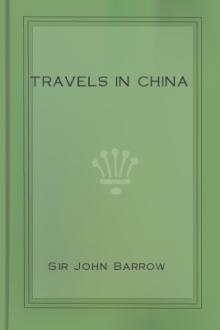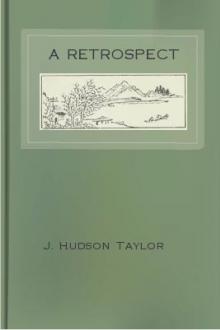Travels in China, Sir John Barrow [phonics readers txt] 📗

- Author: Sir John Barrow
- Performer: -
Book online «Travels in China, Sir John Barrow [phonics readers txt] 📗». Author Sir John Barrow
There is not a water-closet, nor a decent place of retirement in all China. Sometimes a stick is placed over a hole in a corner, but in general they make use of large earthen jars with narrow tops. In the great house we occupied was a walled inclosure, with a row of small square holes of brick-work sunk in the ground.
Next to the pagodas, the most conspicuous objects are the gates of cities. These are generally square buildings, carried several stories above the arched gateway and, like the temples, are covered with one or more large projecting roofs. But the most stupendous work of this country is the great wall that divides it from northern Tartary. It is built exactly upon the same plan as the wall of Pekin, being a mound of earth cased on each side with bricks or stone. The astonishing magnitude of the fabric consists not so much in the plan of the work, as in the immense distance of fifteen hundred miles over which it is extended, over mountains of two and three thousand feet in height, across deep vallies and rivers. But the elevations, plans, and sections of this wall and its towers have been taken with such truth and accuracy by the late Captain Parish, of the Royal Artillery, that all further description would be superfluous. They are to be found in Sir George Staunton's valuable account of the embassy to China.
The same Emperor, who is said to have committed the barbarous act of destroying the works of the learned, raised this stupendous fabric, which has no parallel in the whole world, not even in the pyramids of Egypt, the magnitude of the largest of these containing only a very small portion of the quantity of matter comprehended in the great wall of China. This indeed is so enormous, that admitting, what I believe has never been denied, its length to be fifteen hundred miles, and the dimensions throughout pretty much the same as where it was crossed by the British Embassy, the materials of all the dwelling-houses of England and Scotland, supposing them to amount to one million eight hundred thousand, and to average on the whole two thousand cubic feet of masonry or brick-work, are barely equivalent to the bulk or solid contents of the great wall of China. Nor are the projecting massy towers of stone and brick included in this calculation. These alone, supposing them to continue throughout at bow-shot distance, were calculated to contain as much masonry and brick-work as all London. To give another idea of the mass of matter in this stupendous fabric, it may be observed, that it is more than sufficient to surround the circumference of the earth on two of its great circles, with two walls, each six feet high and two feet thick! It is to be understood, however, that in this calculation is included the earthy part in the middle of the wall.
Turning from an object, which the great Doctor Johnson was of opinion would be an honour to any one to say that his grandfather had seen, another presents itself scarcely inferior in point of grandeur, and greatly excelling it in general utility. This is what has usually been called the imperial or grand canal, an inland navigation of such extent and magnitude as to stand unrivalled in the history of the world. I may safely say that, in point of magnitude, our most extensive inland navigation of England can no more be compared to the grand trunk that intersects China, than a park or garden fish-pond to the great lake of Winandermere. The Chinese ascribe an antiquity to this work higher by many centuries than to that of the great wall; but the Tartars pretend it was first opened in the thirteenth century under the Mongul government. The probability is, that an effeminate and shameful administration had suffered it to fall into decay, and that the more active Tartars caused it to undergo a thorough repair: at present it exhibits no appearances of great antiquity. The bridges, the stone piers of the flood-gates, the quays, and the retaining walls of the earthen embankments are comparatively new. Whether it has originally been constructed by Chinese or Tartars, the conception of such an undertaking, and the manner in which it is executed, imply a degree of science and ingenuity beyond what I suspect we should now find in the country, either in one or the other of these people. The general surface of the country and other favourable circumstances have contributed very materially to assist the projector, but a great deal of skill and management, as well as of immense labour, are conspicuous throughout the whole work.
I shall endeavour to convey, in a few words, a general idea of the principles on which this grand undertaking has been carried on. All the rivers of note in China fall from the high lands of Tartary, which lie to the northward of Thibet, crossing the plains of this empire in their descent to the sea from west to east. The inland navigation being carried from north to south cuts these rivers at right angles, the smaller streams of which terminating in it afford a constant supply of water; and the three great rivers, the Eu-ho to the north, the Yellow River towards the middle, and the Yang-tse-kiang to the south, intersecting the canal, carry off the superfluous water to the sea. The former, therefore, are the feeders, and the latter the dischargers, of the great trunk of the canal. A number of difficulties must have arisen in accommodating the general level of the canal to the several levels of the feeding streams; for notwithstanding all the favourable circumstances of the face of the country, it has been found necessary in many places to cut down to the depth of sixty or seventy feet below the surface; and, in others, to raise mounds of earth upon lakes and swamps and marshy grounds, of such a length and magnitude that nothing short of the absolute command over multitudes could have accomplished an undertaking, whose immensity is only exceeded by the great wall. These gigantic embankments are sometimes carried through lakes of several miles in diameter, between which the water is forced up to a height considerably above that of the lake; and in such situations we sometimes observed this enormous aqueduct gliding along at the rate of three miles an hour. Few parts of it are level: in some places it has little or no current; one day we had it setting to the southward at the rate of one, two, or three miles an hour, the next to the northward, and frequently on the same day we found it stationary, and running in opposite directions. This balancing of the level was effected by flood-gates thrown across at certain distances to elevate or depress the height of the water a few inches, as might appear to be necessary; and these stoppages are simply planks sliding in grooves, that are cut into the sides of two stone abutments, which in these places contract the canal to the width of about thirty feet. There is not a lock nor, except these, a single interruption to a continued navigation of six hundred miles.
The most remarkable parts of this extraordinary work will be noticed in a following chapter, descriptive of our journey through the empire.
Over this main trunk, and most of the other canals and rivers, are a great variety of bridges, some with arches that are pointed not unlike the gothic, some semicircular, and others shaped like a horse-shoe: some have the piers of such an extraordinary height that the largest vessels, of two hundred tons, sail under them without striking their masts. Some of their bridges, of three, five, and seven arches[21], that cross the canal, are extremely light and beautiful to the eye, but the plan on which they are usually constructed does not imply much strength. Each stone, from five to ten feet in length, is cut so as to form a segment of the arch, and as, in such cases, there is no key-stone, ribs of wood fitted to the convexity of the arch are bolted through the stones by iron bars, fixed fast into the solid parts of the bridge. Sometimes, however, they are without wood, and the curved stones are morticed into long transverse blocks of stone, as in the annexed plate, which was drawn with great accuracy by Mr. Alexander.
In this Plate,
CHINESE BRIDGE
There are, however, other arches wherein the stones are smaller and pointed to a centre as in ours. I have understood from the late Captain Parish, that no masonry could be superior to that of the great wall, and that all the arched and vaulted work in the old towers was exceedingly well turned. This being the case, we may probably be not far amiss in allowing the Chinese to have employed this useful and ornamental part of architecture before it was known to the Greeks and the Romans. Neither the Egyptians nor the Persians appear at any time to have applied it in their buildings. The ruins of Thebes and of Persepolis have no arches, nor have those of Balbec and Palmyra; nor do they seem to have been much used in the magnificent buildings of the Romans antecedent to the time of Augustus. The grand and elegant columns of all these nations were connected by straight architraves of stone, of dimensions not inferior to the columns themselves. In the Hindoo excavations are arches cut out of the solid mountain; but when loose stones were employed, and a building was intended to be superstructed on columns, the stones above the capitals were overlaid like inverted steps, till they met in a point in the middle above the two columns, appearing at a little distance exactly like the gothic arch, of which this might have given the first idea. If then the





Comments (0)